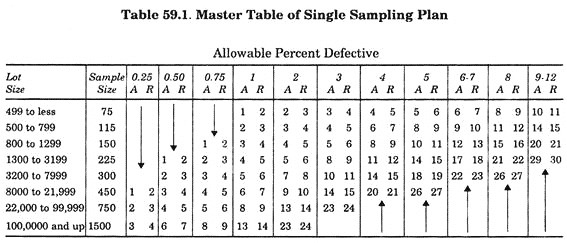Appendix A contains a portion of random number table. For convenience of readers, the digits are grouped into sets of 3 and are arranged in 12 rows on each page.
For obtaining random number, a pencil may be dropped blindly and the starting point for reading of the numbers shall be the random digit nearest to the spot indicated by the pencil.
The random number, may then be read up or down, right or left, but it may perhaps be more convenient to read them vertically down-ward till the bottom of the page is reached and there after the numbers in the adjacent column to the right are read starting from the top of the page and moving downward as earlier. This systematic method of reading the numbers may be carried on to the succeeding pages, if necessary.
If the random number to be chosen consists of single digit (as would be the case when lot size does not exceed 10) then the digit of any single column may be used, taking 0 to represent 10.
ADVERTISEMENTS:
If the random number to be chosen consists of two digits (as would be the case when lot size does not exceed 100) when any two adjoining column may be used taping to represent 100. If the random numbers to be chosen consist of three or more digits then a similar method as explained above may be followed.
Example:
Suppose it is required to obtain a sample of 10 components from a lot of 200. If the components in the lot are assigned serial numbers upto 200, the problem then becomes to obtain 10 random numbers in the 1 to 200. Taking the 3 digit random numbers from Appendix A and starting from any number, say 190, occurring in the eleventh row proceeding downwards, the numbers so obtained are 190, 91, 45, 10, 90, 29, 93, 83, 65 and 28.
ADVERTISEMENTS:
While in upward direction these are 190, 48, 17, 22, 44, 40, 93, 33, 72 and 62. The components in the lot corresponding to these numbers shall then be selected to constitute the required random sample of size 10.
A = Acceptance Number
R = Rejection Number
ADVERTISEMENTS:
Arrows →: When there is an arrow, below given, i.e. allowable Percent defective, use first sampling data below arrow in upper left-hand corner (Forming large lot if possible) or first sampling data above arrows in lower right-hand, as the case may be.


